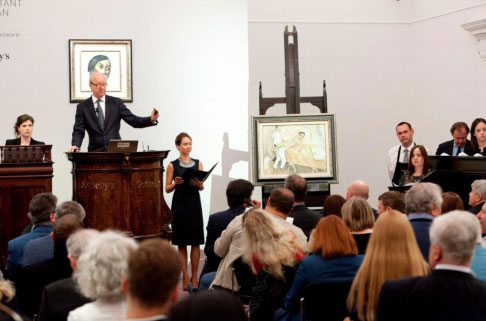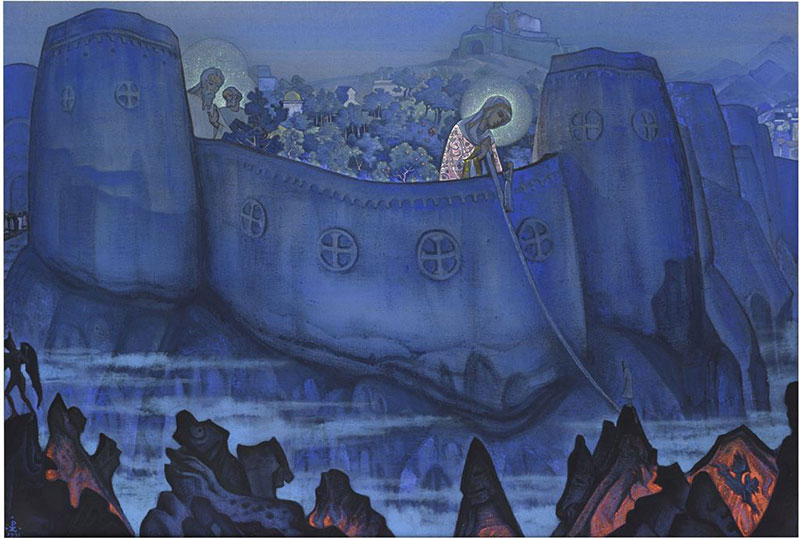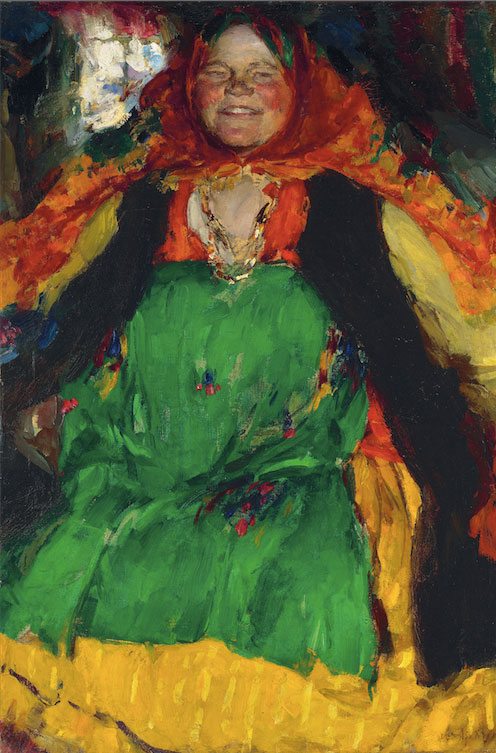As Russian Art Week approaches what is the state of the Russian Art Market?
Nov 13th, 2014 | By Ivan Lindsay | Category: JournalARTICLE: The State of the Russian Art Market Ahead of November’s Russian Art Week, by Ivan Lindsay for the Russianartandculture website

Lord Poltimore at Russian Art Week. Photo courtesy of Sotheby’s
Prominent art dealer and author Ivan Lindsay takes a look at the Russian art market prior to London’s forthcoming Russian Art Week.
It’s early November in a wet and windy London, and dealers and collectors are trying to gauge confidence in the Russian art market prior to the bi-annual Russian Art Week that will happen in London 21st–28th November.
Many are concerned, as the news of late has been almost entirely negative. Moody’s has recently warned that Russian companies face a credit crunch as sanctions reduce their access to international capital markets. According to data provided by Russia’s Central Bank, Russian companies and banks must repay US$134bn in external debt by the end of 2015, and the figures are considerably higher for 2016 and 2017. It was hoped that Chinese lenders would take up the slack but the Chinese are proving wary of US sanctions and this is reflected in the current lending figures. According to the Financial Times the largest Chinese lender to Russia, the Industrial and Commercial Bank of China had only lent US$83m to Russia by the beginning of September and all Chinese loans to Russia have to be approved by China’s Central bank.

Roerich’s Madonna Laboris, sold for a record £7.9m at Russian Art Week 2013. Courtesy of Bonhams
The ex-Goldman trio headed up by the Goldman Sachs former Moscow chief, Edward Eisler, have abandoned their $2bn fundraising efforts to invest in Russia, and Total has pulled out of its joint venture with Russia’s Lukoil to explore shale gas in western Siberia. Leading businessmen such as Steve Schwarzman, head of Blackstone, which now manages over US$300bn in assets across private equity, credit, real estate and hedge funds, have said they are no longer considering Russian investments. The UK has recently proposed cutting Russia off from the SWIFT system, which would deny any wire transfers in and out of the country.
While the situation in Eastern Ukraine remains fragile, with the ceasefire sort of holding up, Russia has started to retaliate against Western sanctions, initially banning food imports, and most recently discussing changing the law to allow the legal seizure of non-Russian-owned assets in Russia. Capital flight from Russia has intensified, with the Financial Times estimating a capital outflow of US$74bn in the first six months of the year. Quite how this capital exits Russia is unclear because, although Russia has no restrictions on inflows, it does have capital controls on outflows. Vladimir Tikhomirov, chief economist at BSC Prime, said, “Net capital outflow will grow quite significantly in the second half both year-on-year and compared to the first six months.” In addition, the current oil price of around $90 a barrel will put further pressure on Russia’s balance sheet, as they need a price of around $120 a barrel for the budget to break even.
However, it is this capital outflow that could potentially have a more significant impact on the Russian art market than the Ukrainian troubles and sanctions. This wall of Russian cash held outside of Russia is looking for a home and could drive the Russian art market higher, irrespective of the poor international situation. Sotheby’s, the market leader in Russian auctions, who are participating with a sale in the forthcoming November art week, certainly think so, and Emily Kodama, their assistant vice president for Russian paintings, says she has seen no negative impact on the Russian art market from the current turmoil. Miss Kodama is bullish for the November sales, saying, “We’re finding, regardless of whatever socio-political situation is going on in the world, if you have a great property, people are willing to pay a high price for it.”

One of this year’s top lots: Arkhipov’s Peasant Woman in a Green Sarafan. Photo courtesy of Christie’s
And a report just out by Deloitte and Art Tactic, “The Art and Finance Report 2014”, would seem to agree with her. For anyone who can cope with an accountants’ and statisticians’ take on the art market (all 130 pages of it), the report is available online.The report concludes that the Russian art market rose 21% from 2012 to 2013. Sotheby’s June 2014 sale raised £23.8m and Christie’s £24m. The report states that while sales in Moscow are slow (particularly contemporary art) due to sanctions and the weakening economy, international sales during the first half of 2014, “reveal renewed confidence in this market … and this is likely to highlight the advantages of art as a tangible and movable asset for collectors.”
The auction houses have not yet revealed how strong their November sales will be; hopefully, they will have some outstanding paintings as the market is following the trend in the Western art market by becoming increasingly polarised, i.e. it is divided into ‘the best’ and ‘the rest’ … and no one is interested in ‘the rest’ any longer.
If the market holds up, and it probably will, then prices will be strong for any of the classics, and they will continue to strengthen for the art of the Soviet period, which is the fastest-growing area of the market. Taste always moves later, and since there is very little early 20th-century Russian art on the market, and even less Avant Garde, some of the leading collectors are now focusing on the Realist school of the 1950s and the Severe Style artists of the 1960s.
It will depend on to what extent collectors have been rattled by the volatile situation in Ukraine and the resulting sanctions. What is for sure is that the art money is there, it’s outside of Russia and looking for a home, and the art market will continue to accommodate it as long as confidence holds up.
Ivan Lindsay is a London-based art dealer and writer specialising in 20th century Russian paintings and sculpture with a particular interest in art created during the Soviet period. His book, ‘The History of Loot and Stolen Art,’ was published earlier this year by the Unicorn Press. For more information Amazon http://www.amazon.co.uk/The-History-Loot-Stolen-Art/dp/1906509212
For more information on Russian Art Week, visit the official website. http://www.russianartweek.co.uk/
